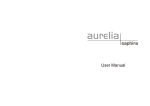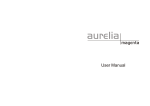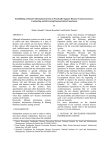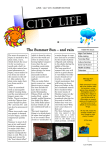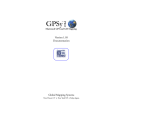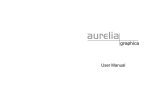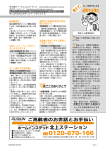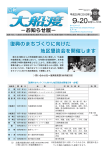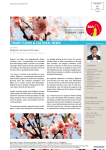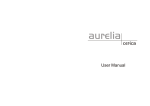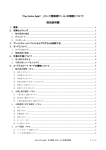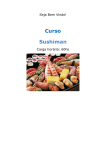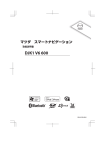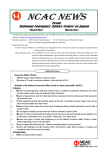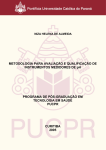Download Real Ideas and Lessons
Transcript
One year since the Great East Japan Earthquake… Here’s what our employees in Tohoku experienced and learned firsthand! Real Ideas and Lessons Important messages for all Ricoh San-ai Group employees and their families to help prepare for the future Communicating Experiences of the Disaster One year has passed since the earthquake. Rather than let the experiences of the Ricoh Group employees in the Tohoku area fade away, we hope that by communicating those experiences... we can help save lives and minimize any damage. To that end, the Ricoh Group employees in Tohoku were kind enough to give us their thoughts, even though they are still recovering from the painful experience. We gathered messages about the experiences of the disaster from many employees. We received 207 messages, broken down as follows. Ricoh Japan – 90 messages, Ricoh Technosystems – 93 messages, San-ai Logistics, Eastern Division – 22 messages, Ricoh Business Expert – 2 messages Thank you very much for all the support and encouragement we received during this disaster from the Ricoh Group. With our lifeline cut off and no distribution of goods, we were at home, cleaning up the mud and the remains of our things in despair - That’s when Ricoh’s truck came and delivered the necessities. We clasped our hands and it really brought tears to our eyes. Because of you, now we can go to work as normal. We’re grateful for what you’ve done for us. Looking back at that time, we are sharing these experiences with the hope that we can repay everyone for their generosity. We’d be happy if this pamphlet helped you, even just a little. There’s no avoiding natural disasters. All we can do is pray that this kind of serious disaster never happens again. However, we believe that with proper preparation, we can keep damage. <A message from the employees at Ricoh Japan, Tohoku Sales and Marketing Division> P.2 We have condensed each and every thought into these messages we want to share “Real Ideas and Lessons” (Important messages for all Ricoh San-ai Group employees and their families to help prepare for the future) to all Ricoh Group employees, as preparation for an emergency. We would like to express our deep gratitude to all the employees in the Tohoku area who offered their messages, as well as ask all our Ricoh Group employees and their families never to forget these important messages, using them to “prepare for the future”. The messages we present in this pamphlet summarize all the lessons from the experiences of our employees and their families who lived through the Great East Japan Earthquake. Accordingly, please be aware that these messages may not apply to all disasters. If a disaster should strike, how will you prepare, how will you act? P.3 “Important messages” gained from experiences of the disaster Idea 1 An earthquake is chaotic. Remember the five-step response! P.10 Step 1 - It’s an earthquake! 30 seconds - Protect yourself. Step 2 - The shaking stopped! 3 minutes - Evacuate to a safe place. Step 3 - Is everyone OK? 3 hours - Make sure your family is safe. Step 4 - I want to see them now! 30 hours - Meet up with your family. Step 5 - Patience is important. 3 days - Hold out until you can return to daily life. “You're on your own in a tsunami!” “Save yourself!” (One of the traditions for responding to tsunamis in the Sanriku coastal area) P.12 “You're on your own in a tsunami!” and “Save yourself!” are sayings related to tsunamis that basically mean, respectively, “If there’s a tsunami, leave everything behind, don’t worry about your relatives, and escape to high ground by yourself” and “you must protect your own life”. They both bear the deeper meaning that rather than let the whole family die, it’s better to have even just one descendant overcome the hardship and survive. Idea 2 Idea 3 Put a poster up in your house so your family knows where to go! P.19-P.20 If you can’t contact your family, place a poster on the house to notify them of your whereabouts. By writing the evacuation location, your family members’ names, the time, and a message on the poster, you can meet up again smoothly. Idea 4 Tsunamis go upstream. Quick, get far away! P.12-P.13 When a tsunami occurs, it flows up rivers very quickly. It’s important to evacuate to high ground far away from rivers. Never get closer to rivers. Tsunamis come more than once. Don’t go home until the alarm is called off! P.12- P.14 Once you’ve evacuated and escaped the tsunami, you have to stay away from the ocean or rivers. During a serious disaster, people tend to panic, and if someone says, “I think it’s safe to go back,” people believe it and go home to get their valuables, then end up dying. Idea 5 Idea 6 Create a network of the mothers of your children's classmates! P.15 During the disaster, there were parents who were worried because they hadn’t received any contact from the day-care center where they left their children. Some parents were able to confirm their child’s safety after being contacted by another mother they exchanged text messages with regularly, saying that their child was safe. Preparing for a disaster and building a network of the mothers of classmates was a great help. Idea 7 If you can't call, send a text message. It might be delayed but it will definitely get through! You can trust the disaster message board/disaster message dial! Public phones are given priority in a disaster! P.17 If your phone doesn’t have service, send a text message as it will definitely arrive even if it is delayed. Use the disaster message board and the disaster message dial, too. If there’s a public phone nearby, it’s line will be given priority, so it’s likely your call will connect. P.4 “Important messages” gained from experiences of the disaster Idea 8 Use vending machines that respond to disasters! P.22-P.23 If the lifeline has been cut off in a disaster, there are vending machines that provide drinks free of charge. Look for them in advance around your home and on the way to work or school. Beware of the danger from secondary disasters! Don’t just check safety Idea 9 once! P.17 Even after you save yourself and your family from the original disaster, there is always a possibility of secondary disasters, such as the tsunami in this case. You need to check on your family’s safety 2 or 3 times. Idea 10 Prepare for disaster and decide on a place to meet up with your family! P.19 Decide evacuation sites for each family member and a meeting place in advance. It’s important to get a disaster prevention map for your community and practice walking the evacuation route around your house. Idea 11 If disaster strikes when you’re at home, run to your toilet or bathroom! P.10 If you feel shaking when you’re at home, run to a place with narrow spaces between pillars, like the toilet or bathroom. They're structurally safer compared to the rest of the house. You have to be careful though because if the door becomes deformed, you might end up stuck in that room. Get in the habit of opening the door if you feel even a small shake. Idea 12 Your family car is a secret evacuation site! P.10 If an earthquake strikes when you’re home, and there’s a chance your furniture might fall over or your house might collapse, then your car is an effective temporary shelter. Vehicles have various equipment and functions, such as radio, television, and air conditioning. Idea 13 Don’t forget! Stock up on emergency necessities and baby supplies! P.26 You must stock up on things for your children, your primary concern. During the disaster, supermarkets quickly ran out of milk and diapers, so regularly stock up on extra. Chocolate and cookies, which kids love, are very convenient because they can be eaten quickly when hungry and also supply nutrients. Disasters also make children anxious, so prepare some toys to help reduce the stress. Also, necessities like toilet paper and sanitary products will be difficult to find, so you need to stock up. Idea 14 Decide who will go and pick up your children! P.19 Prepare for emergencies and decide in advance who in your family will go and pick up the children. Then, in case of emergency, you can handle the situation and meet up with your family without panicking. Also, if you tell your children, they can wait to be picked up without worrying. P.5 “Important messages” gained from experiences of the disaster Idea 15 Your designated evacuation site isn’t necessarily safe! P.12 A fire station facing a fishing port in Miyagi Prefecture was designated as an evacuation site, and stairs were even installed on the outside to reach the roof. However, the tsunami covered the roof, and a lot of people died. Idea 16 Use emergency aid stations during a disaster! P.22, P.24 There are convenience stores, family restaurants, schools, post offices, gas stations and similar locations that have agreed to provide support for persons having difficulty returning home during a disaster by providing tap water and toilets, as well as information about the disaster and roads, to those walking home during a disaster. Places that agreed to help in this manner have a sticker posted, so be sure to check for them. Idea 17 If your house or apartment has a hot-water heater (water tank), you can use water even during a disaster! P.29 You can use water for general use during a disaster. In general, use the water for washing your hands, bathing, or cleaning the toilet. Do not drink it directly, as water from water tanks is not safe for drinking. Idea 18 Your cell phone charger will definitely help you! P.17 During the disaster, there were people whose cell phones went dead and were in trouble, unable to use them. If you prepare an extra cell phone charger, when disaster strikes, you can not only confirm if your family is safe, but it is also very useful to use the television or camera functions to share disaster information. Idea 19 If your car’s gas tank is down to half, fill her up! P.29 You never know when a disaster might occur. Take care to keep your car full of gas so that you can use it whenever it might be necessary. Idea 20 Use this one device to ensure both heating and cooking! P.28 An oil heater is very useful when electricity and gas have stopped flowing. You can not only use it for heat, but can also use it for cooking, such as boiling, heating, and grilling. Idea 21 Aroma candles only cost ¥100 but last 3 days! P.28 The blackout continued and we couldn’t use electricity for a while. People have said the aroma candles they just happened to have were unexpectedly effective and lasted for 3 days. It’s inconvenient being in the dark without light. Aroma candles are inexpensive and easy to find, so it’s worth considering them as emergency supplies. P.6 For your loved ones P.7 Contents It's an earthquake! 30 seconds Protect yourself. Page Lesson 1 An earthquake is chaotic. Remember the five-step response! P.10 Lesson 2 Under your desk is a safe area! P.10 Lesson 3 Be aware of emergency exits and windows, and the building's structure! P.10 Lesson 4 If you're home, run to the toilet or bathtub! P.10 Lesson 5 Your family car is a secret evacuation site! P.10 The shaking stopped! 3 minutes Evacuate to a safe place. Page Lesson 6 When you're in a tsunami zone, check for higher ground! P.11 Lesson 7 Run at full speed to high ground, even if you can't see a tsunami! P.11 Lesson 8 "You're on your own in a tsunami!" "Save yourself!" P.12 Lesson 9 Your designated evacuation site isn't necessarily safe! P.12-P.14 Lesson 10 Tsunamis go upstream. Quick, get far away! P.12-P.13 Lesson 11 Tsunamis come more than once. Don't go home until the alarm is called off! P.12-P.14 Is everyone OK? 3 hours Make sure your family is safe. Page Lesson 12 Create a network of the mothers of your children's classmates! P.15 Lesson 13 Always be aware of where your children are! P.15 Lesson 14 Get to know your neighbors, and help each other in an emergency! P.15-P.16 A text message will definitely arrive even if it is delayed! You can trust the disaster message board / disaster message dial! Lesson 15 Public phones are given priority in a disaster! Net communication works well in a disaster! Lesson 16 Let everyone know that you're safe on an SNS! P.17-P.18 Lesson 17 Beware of the danger from secondary disasters! Don't just check safety once! P.17 P.17 I want to see them now! 30 hours Meet up with your family. Lesson 18 Discuss where youl'll meet up in a family meeting! Lesson 19 Put a poster up in your house so your family knows where to go! Lesson 20 Decide who will go and pick up your children! Page P.19 P.19-P.20 P.19 Lesson 21 Get to know the route from your work to your home! P.19, P21 Lesson 22 Use vending machines that respond to disasters! P.22-P.23 Lesson 23 Use emergency aid stations during a disaster! P.22, P.24 Patience is important. 3 days Hold out until you can return to daily life. Page Lesson 24 Enough water for one day! P.25 Lesson 25 Think about emergencies and buy extra food in your everyday life! P.25 Lesson 26 Diapers and milk disappear from supermarkets! Children can't stand it when they get hungry. Prepare some sweets Lesson 27 in your food stock! P.26 Lesson 28 Toys are best for getting rid of children's worries! P.26 Lesson 29 Your cell phone will definitely help you! P.27 Lesson 30 An SNS is effective for gathering local information! P.27 Lesson 31 Aroma candles only cost ¥ 100 but last 3 days! P.28 Lesson 32 Use this one device to ensure both heating and cooking! P.28 Lesson 33 Keep water in your bathtub for an emergency! P.28 Lesson 34 If your car's gas tank is down to half, fill her up! P.29 Lesson 35 You can use the water from a hot-water heater (with a tank) for general use! P.29 P.26 List of things that are helpful in a disaster! P.30 /Sites recommened by everyone from Tohoku! P.31 It’s an earthquake! 30 seconds after it happens Protect yourself. You never know when an earthquake will happen. Imagine an earthquake occurring in your everyday life. Lesson 1 Lesson 2 Protect yourself An earthquake is chaotic. Remember the five-step response! Step 1 - It’s an earthquake! 30 seconds - Protect yourself. Step 2 - The shaking stopped! 3 minutes - Evacuate to a safe place. Step 3 - Is everyone OK? 3 hours - Make sure your family is safe. Step 4 - I want to see them now! 30 hours - Meet up with your family. Step 5 - Patience is important. 3 days - Hold out until you can return to daily life. Under your desk is a safe area! The shaking was intense. Glass in the office broke and cabinets fell over, and I was scared the office would collapse. When the shaking stopped, I went outside, and roof tiles were scattered all around. If I had run outside… I might’ve gotten hurt. I think I made the right decision to wait under my desk until the shaking stopped. <Ms. A> Lesson 3 Be aware of emergency exits and windows, and the building’s structure! Lesson 4 If you’re home, run to the toilet or bathroom! Be aware of the building’s structure Lesson 5 Falling things P.10 The shaking was so bad I thought the building would collapse. Glass shattered and roof tiles fell off. From this experience, I started paying attention to the building’s structure, dangerous places like glass and lockers, and the location of emergency exits, even when I visit a customer. I think it’s also important not to just quickly jump outside, but to first protect your head and protect yourself. Even if you’re home, it’s effective to run to a place where there’s nothing that can fall over and is narrow with many pillars (the toilet or the bathroom). However, it’s important not to close the door so you don’t get shut in. <Ms. B> Your family car is a secret evacuation site! My elderly mother was at home when the earthquake struck. The inside of the house is dangerous if there are aftershocks, so once the shaking calmed down, she evacuated to the family car. There was nothing that could come falling down inside the car, so she was safe. <Ms. C> * However, using your family vehicle as shelter is dangerous in areas to be evacuated for tsunamis. The shaking stopped! 3 minutes after it happened Evacuate to a safe place. If you're near the coast when an earthquake occurs, don't panic and quickly evacuate to higher ground. When you’re in a tsunami zone, check for higher ground! Lesson 6 Responding to a tsunami 6 months before the disaster, I was transferred from inland to near the shore. When I came to the shore, the first thing I thought was that there were a lot of signs that said "Estimated Tsunami Inundation Area", all over town. They were even in areas quite far from the ocean. But, I couldn’t find a sign for a tsunami shelter anywhere, and didn’t know where someone unfamiliar with the area should evacuate to. Most of the area I was in charge of was in an "Estimated Tsunami Inundation Area", so I thought I’d die for sure if a tsunami came when I was at work. That's when I got in the habit of checking for higher ground or a tall hill where I can evacuate to whenever I visit a new place. <Mr. D> Be sure to check the signs in a coastal area! Tsunami Caution Lesson 7 Responding to a tsunami Tsunami Evacuation Site Tsunami Shelter Building Run at full speed to high ground, even if you can’t see a tsunami! A disaster warning was broadcast that said the tsunami was not high, but I lost two family members because they didn’t run away quickly. I truly felt how important it is to evacuate, no matter what. <Mr. E> P.11 The shaking stopped! 3 minutes after it happened Evacuate to a safe place. Many people survived this earthquake because they followed the tradition for disasters in the Sanriku region, expressed by the phrase, “You're on your own in a tsunami” (if there’s a tsunami, leave everything and escape by yourself). Lesson 8 On your own “You're on your own in a tsunami!” “Save yourself!” If I ever found myself in that situation, I couldn’t leave my family behind and escape by myself. However, there’s no guarantee you’ll be with your relatives when disaster strikes. In such an event, everyone should remember each person is “on their own”. <Mr. F> Lesson 9 Your designated evacuation site isn’t necessarily safe! Lesson 10 Tsunamis go upstream. Quick, get far away! Responding to a tsunami Your top priority is to leave your car behind and get to high ground or a tall building. You can’t say the designated evacuation site is definitely safe. It’s safer to evacuate to a place you’re instructed to by an expert in the area. Tsunamis go upstream, so never get close to a river. <Ms. G> Lesson 11 Tsunamis come more than once. Don’t go home until the alarm is called off! Responding to a tsunami Everyone around me urged me to escape, so I left my car and evacuated. There was a huge noise and a cloud of dirt, and the tsunami came rushing ashore. Before I knew it, I was surrounded by water. I’ll never forget that terror. Those who stayed behind or went to get their valuables died. Once you evacuate, absolutely do not return until you are informed that it is completely safe. <Mr. H> These places are dangerous in a tsunami! P.12 Shores: Bays/Capes: Rivers: Tsunamis grow in height in shallow water. Tsunamis grow in height in bays or places with complex topography. Tsunamis go upstream. There’s records of a tsunami that surged through the mouth of a river and flowed some four kilometers upstream. Your designated evacuation site isn’t necessarily safe! z Lessons from tsunamis The tsunami swallowed up even designated evacuation sites, which were supposed to be safe. Government branch offices, schools, high ground… “Unbelievable, even here.” This huge tsunami surpassed expectations and stole the lives of many people who obeyed the instructions of local authorities. The Ishinomaki City Kitakami General City Center was newly built 5 years ago to prepare for a tsunami, facing the mouth of the Kitakamigawa River in the same city. Built on land 6.5 meters high, a meter above the maximum predicted tsunami height, this building was designated as an evacuation site, but was completely destroyed in the great wave which surpassed the second floor roof. Among the 49 people who came to the City Center, including elderly, a total of only three people (two city officials and one child) survived. Teruyoshi Makino, a city official (age 42), said, “The evacuation was perfect, but the power of the tsunami surpassed that.” March 22, 2011 – From Asahi Shimbun Digital z The reason people couldn’t escape from the tsunami The top reason people couldn't escape from the tsunami was: "The evacuation site wasn't safe." This is also a message from our employees. To reduce risk from tsunamis, we believe it is important to be sure to understand the local geography if you live in tsunami areas, bear in mind that the tsunami might reach even evacuation sites, and to make efforts to evacuate to even higher ground. z The reason people moved from the first evacuation site There were many people who, despite having evacuated, returned to look for their family or check on their house and subsequently lost their lives. Tsunamis can come more than once. No matter the reason, you must absolutely never return to the area until you are informed that it is completely safe. P.13 Tsunamis keep coming. Don’t return until you have been informed that it is safe! In the tsunami in the Great East Japan Earthquake, a run-up height of 39.7 m was locally observed in Ryoriwan Bay in Ofunato City, Iwate Prefecture. ■ Fire and Disaster Management Agency “ Tsunami Preparation ” Mechanism of tsunami generation ①Seabed rises due to the occurrence of a subduction zone earthquake. ②Sea level rises with the rise in the seabed. After the first wave, the second and third waves attack in succession. ・The tsunami piles up as this process is repeated. ① ② You should evacuate to the nearest high land or evacuation area. ・In Japan, the municipality designates the evacuation areas and escape routes for the evacuees. ③ Evacuation continues for a while because the tsunami recurs. ④ If you cannot outrun the tsunami, you should evacuate to a substantial building. ・In Japan, the designation of “evacuation buildings” (reinforced concrete buildings of three or more stories) is being promoted. In the Great East Japan Earthquake, there were places where the tsunami reached the 4th floor. Evacuate to someplace higher! ⑤ P.14 ⑥ Is everyone OK? 3 hours after it occurred Make sure your family is safe. Build a network with your neighborhood and friends, so that you can check if your children and the elderly are safe in an emergency. Lesson 12 Create a network of the mothers of your children's classmates! Lesson 13 Always be aware of where your children are! Children’s safety Lesson 14 Elderly person living alone I have a kindergartener and a child in elementary school. I don’t let them have cell phones, so in emergencies, their teachers call or text me. I couldn’t contact them immediately, but I got a text from a friend with a child at the same day-care center, and found out my child had safely evacuated. It’s very important to check where your children are! Always know where they are at all times. <Ms. I> Get to know your neighbors, and help each other in an emergency! If you have an elderly person who can’t evacuate on their own in your family, it’s very important you communicate with your neighbors in your everyday life, creating a neighborhood that cooperates together in an emergency. <Mr. J> P.15 Get to know your neighbors in your everyday life, and help each other in an emergency! From the 2011 edition of the Disaster Prevention White Paper Of those who died in the Great East Japan Earthquake, 64.4% were 60 years old or older, and the death rate rises with age. We can see that running away and escaping from a tsunami is more difficult the older one is. It is believed this is also affected by the fact that many people with elderly family members were not at home, but rather, were working as the earthquake occurred on a Friday. ■ In Akita City, leaflets like the following are issued to encourage and assist people to help out each other on a local level. These leaflets explain that having a friendly neighborhood relationship in one’s daily life is the first step to preparing for disaster prevention. P.16 Is everyone OK? 3 hours after it occurred Make sure your family is safe. Discuss the method for confirming safety in an emergency. A text message will definitely arrive even if it is delayed! Lesson 15 You can trust the disaster message board/disaster message dial! Public phones are given priority in a disaster! I had a lot of difficulty getting in touch with my family. I called my wife at home with my cell but I couldn’t get through. I was able to make sure my child, who was out of the prefecture, was safe after about 30 minutes by texting. A text will get through, even if it gets there late. In the future, everyone in my family will become familiar with using the disaster message board and disaster message dial. If you can’t take a cell phone with you, use a public phone. <Mr. K> Make sure your family is safe Net communication works well in a disaster! Let everyone know that you’re safe on an SNS*! Lesson 16 Just after this disaster, there was a limit on cell phone communication, so most calls couldn’t get through. Even text messages were very unreliable. Somehow I managed to get in touch with my family and make sure they were safe. However, to prepare for the future, we discussed it as a family, and decided to check the disaster dial and to create Twitter and Facebook accounts to ensure a method for communication! <Ms. L> Confirm safety with an SNS * SNS stands for social network service. It refers to websites that provide services with a registration system for communities that promote and support interpersonal connections. Lesson 17 Check safety multiple times Beware of the danger from secondary disasters! Don’t just check safety once! Check several times after some time passes! Keep in mind that with tsunamis and aftershocks, the situation is always changing! <Ms. M> In a disaster, use public phones! Public phones are designated as “priority phones” and can be used free of charge in a serious disaster. Analog public phones You need a ¥10 coin, but you’ll get it back after your call. Can be used even during a blackout! Digital public phones You can use it just by picking up the receiver. In a blackout, it switches to battery power. If the blackout lasts a long time, the battery will die and it can no longer be used. P.17 How to use the disaster message dial/disaster message board! Use it if your cell phone can’t get through and you can’t send texts. Things to keep in mind regarding use The disaster message dial/disaster message board were established to avoid circuit congestion in the affected area when a large-scale disaster occurs. The recorded contents (30 sec. max.) are deleted after 48 hours. You can try using it on the 1st and 15th of each month, and on days related to disaster prevention. Disaster message dial * You can also put a password on your recording. Prepare for an emergency and decide the land line number or password you’ll use on the recording in advance as a family. Smart phone Land line If you want to let them know you’re safe 1 7 1 Dial! If you want to know if they’re safe Public phone 1 Register the land line number 2 Input the phone number you want to check Record Play Cell phone Disaster message board Cell phone Smart phone When registering Safety information registration Initial Screen Disaster message board You can register or check safety information. Status I’m safe. レ I’m at home. レ Register There’s damage. Check I’m at the shelter. Delete Input a comment I’m fine. Please don’t worry. Settings for automatic e-mail sending Service outline P.18 Checking Checking safety information Please input the cell phone number of the person whose safety information you would like to check. Search Disaster message board top I want to see them now! 30 hours after it occurred Meet up with your family. Discuss the place where you’ll meet up with your family in case of an emergency. Lesson 18 Decide where you’ll meet up in a family meeting! Lesson 19 Put a poster up in your house so your family knows where to go! Decide where to meet up Lesson 20 Decide who’s in charge Lesson 21 Check the evacuation route When I got home without being able to get in touch with anybody, nobody was there. My family had safely evacuated to the evacuation site, but I felt it was necessary to decide where to meet up with my family. In the future, in case of an emergency, we decided to meet up at 1) my house, 2) the designated evacuation site, or 3) my parents’ house, whichever is safest. We’ll tell each other by putting the destination on a poster. <Ms. M> Decide who will go and pick up your children! We decided that, in the future, after making sure everyone is safe using cell phone voice mail, we’ll meet up at my wife’s parents’ house after leaving the office. We decided her parents will pick up my kids at the day-care center, and meet up at my wife’s parents’ house. <Mr. N> Get to know the route from your work to your home! The earthquake on 3/11. I was in Yamada-machi. I knew intuitively that a tsunami was coming. In an emergency broadcast, it was announced that we should evacuate to higher ground, but if you’re not from around here, you wouldn’t know where to evacuate to just from that. However, I walked along and checked the evacuation route in advance, so I was able to evacuate without panicking. If I hadn’t checked it in advance, I might’ve been caught in the tsunami. <Ms. O> P.19 A poster is effective for telling your family you evacuated from the house! The poster also fulfills the roll of telling them you’re safe! The poster is an effective method for contacting your family to tell them where you evacuated to. If you have family members at work and you’re evacuating to a shelter in an emergency, put up a poster on the door of your house with information about your whereabouts. Your family, rushing home from work, will likely stop at the house first. Then, by checking the “poster”, they can not only find out where you went, they can also find out if the family has safely evacuated. It’s even more important that the people who see the poster write that they saw it on the same poster. During a disaster, there’s no guarantee people will stay where they evacuated to, and may evacuate to a place different from the one written on the poster. If family members who first evacuated the house return to check on the house, the poster will inform them of the whereabouts of other family members they couldn't get in contact with, and vice versa. All members can mutually assure the safety of the whole family. Decide as a family where you’ll put the poster! Example of messages to the family using a poster Mom and Taro evacuated to Grandpa’s house. (3/11 – 17:45) After Dad came and checked the poster Mom and Taro evacuated to Grandpa’s house. (3/11 – 17:45) Dad checked this. On the way to Grandpa’s house. (3/11 – 20:10) Poster shows that, of the family of three, the mother and child evacuated. Poster with an added message from Dad that shows he checked the poster and is going to Grandpa’s house, where Mom and Taro evacuated to. * Having a poster also makes it easy for the police, fire department, and city officials to readily check on your safety. P.20 Make a disaster prevention map! Get a disaster prevention map of your area, and decide your route for going home and your evacuation site! z Example route for walking home: From Ginza to Urawa z Example evacuation site: Ginza Junior High School Ricoh Japan Head Office Disaster prevention base/evacuation site: Ginza Junior High School Refer to: MapFan Web http://www.mapfan.com z Disaster prevention maps published by local authorities These maps indicate what kind of risks exist in the area and locations that are more dangerous if a major disaster occurs. They display not only the damage from earthquakes but also the extent of danger from fires and floods according to the location, making it possible to evacuate more efficiently in the event of a disaster. z How to make your own original disaster prevention map 1. Using the route search on MapFan or Google, write in your evacuation route or route for going home in the case of a disaster. If making one with your family, also write the route home from your children’s schools. 2. Mark the following items on the map to understand your local environment in terms of disaster prevention. A. Railroads, major roads, alleys/narrow roads, plazas/parks/open space, waterways/sewers/streams B. Buildings thought to prevent fire from spreading in the event of a spreading fire (fire prevention line) C. Agencies/facilities involved in disaster relief, such as government agencies/medical care agencies D. Facilities helpful for local disaster prevention, such as evacuation sites and disaster prevention sheds with disaster prevention equipment E. Location of households in your neighborhood with someone who will need help in a disaster Filling in the above items will not only help you to more clearly understand what to do in an emergency, but if you create the map with others in your community, you can reduce the danger for people more at risk in a disaster, such as children and the elderly. P.21 I want to see them now! 30 hours after it occurred Meet up with your family. People going home during a disaster have important allies. Check where they are. Lesson 22 Use vending machines that respond to disasters! Lesson 23 Use emergency aid stations during a disaster! Information for supporting going home I learned that there is a vending machine that responds to disasters inside the Sendai Office building. Someone who had experienced the Great Hanshin Earthquake came to Sendai on business when the earthquake struck. This person took drinking water from the disaster vending machine and distributed it to the elderly people who evacuated to the nearby park. Seeing that, I was inspired and helped distribute the drinking water. I’ll never forget the smiles of those old folk. Because public transportation was stopped during this disaster, people were forced to walk home. Many people struggled with a lot of things, such as finding information on the route home, information about evacuation sites, finding toilets, and obtaining drinking water. <Ms. P> Vending machines that respond to disasters This vending machine provides drinks free of charge during a disaster. Some local authorities install them systematically and provide the information to residents, but most places do not publish the installation information. We Example of the display on a vending have to look for them on our route home and around our machine that responds to disasters homes. Emergency aid stations These places provide support for people walking home, such as tap water, toilets, road information, and disaster information! Places such as convenience stores and chain restaurants are registered. P.22 Stores with these signs Use vending machines that respond to disasters! 災害対応型自動販売機を活用する! Using vending machines that respond to disaster If the lifeline has been cut off in a disaster, there are vending machines that provide drinks free of charge. The number installed varies by area depending on the agreement made with the vending machine companies. Look for them around your home and on the way to work! Efforts of vending machines that respond to disaster from major makers z Coca Cola System If a disaster occurs, this disaster-responsive vending machine can provide soft drinks free of charge to evacuated city residents and is operated by personal computer in a remote location such as the municipal office. Some 400 machines like this were activated during the Great East Japan Earthquake to provide 88,000 free soft drinks to evacuees. Coca-Cola West is one of the Ricoh San-ai Group members, which covers the following areas: Kansai, Chugoku and North Kyushu. Features of the Coca Cola Disaster-Responsive Vending Machine Now providing soft drinks free of charge A packet transmission network is used to display messages on the LED message board and operate the machine to provide free soft drinks. (1) LED Message Board - Provides information to local residents such as regional information and news flashes during normal operation. - Provides messages such as disaster-related information in real time during emergencies. (2) Free Soft Drinks - Provides soft drinks free of charge by remote control operation. z DyDo DRINCO If there’s a blackout from a disaster, this machine can be manually switched to emergency power using a special key, and can provide up to 500 cans within 48 hours after the blackout. Also, this company has signed an agreement to provide drinks during a disaster with local authorities in various areas, and in the event of a large-scale disaster such as an earthquake, designated distribution hubs, as well as vending machines that respond to disasters, will provide their stocked merchandise. Refer to: http://www.dydo.co.jp/corporate/jihanki/disaster.html z Kirin Beverage This machine provides the drinks inside it free of charge during a disaster. The “Can/PET vending machines” can use their built-in batteries to provide merchandise for 48 hours, even during a blackout. The see-through type vending machine doesn’t require a battery. The door opens and you can take the merchandise out. Refer to: http://www.beverage.co.jp/company/guide/expansion/index.html#kanri P.23 Use emergency aid stations during a disaster! ■ What is an emergency aid station? z List of stores that offer support If the local authorities have signed an agreement for supporting those having difficulty returning home during a disaster with a store (such as convenience stores and other locations as listed on the right), then those stores can be used as a relief station providing support for people going home during a disaster. z Coco! z Circle K z Three F z Seven-Eleven z Daily Yamazaki z Family Mart z Poplar z Lawson z Community Store z Sunkus z q's mart z Ministop z Yamazaki Daily Store z Seikatsu Saika z Natural Lawson z Lawson Store 100 z MOS Burger z Yoshinoy a z Yamada Udon z Curry House CoCo Ichibany a z Denny 's z Sizzler z Shakey 's z Roy al Host Convenience stores When transportation is paralyzed during a serious disaster, these stores offer support to people walking home, such as providing tap water and toilets, as well as information from road maps and the radio about the local area and usable roads. Stores that have signed such an agreement have a sticker posted in their window, so check for them when you are on your way to work, and around your neighborhood. Fast food 震災で得られた新たな気づき Family resturants z Gongonpopo z TGI FRiDAY’S Japanese taverns There are other locations, such as gas stations, schools and post offices, that are not in the list on the right but will provide similar support. Karaoke P.24 z Watami z Nagomitei z Wataminchi z Sumishun z Hana no mai z Odo z Yakitori Dojo z Umenoki z Menmaru-Shusainonimaikanban z Zawatami z Ky o-no-y a z Gohan z Gy oten Sakaba z Sakanay a Dojo z Chimney z Danranhono z Chimuni z Big Echo z Karaokekan z Matsuri Iccho & Big Echo Patience is important. 3 days after it occurred Hold out until you can return to daily life. Prepare yourself so that you can survive for three days without support. Lesson 24 Stock up on water Enough water for one day! It was extremely difficult. I wasn’t able to use the water service for a while, and had to wait on line for several hours to be supplied water. After that, when I went to a family restaurant that had reopened, I realized that a cup of cold water, which I always took for granted, could be so precious. I realized that stocking up on water is a very important measure to prepare for emergencies. <Ms. Q> Enough water for one day! To people, water is the source of life. People can live a few weeks without food, but can’t live longer than about five days without water. Losing even just 20% of the water in your body can prove fatal. You can calculate how much water a person needs per day from their weight. Infant, 8 kg⇒1.2λ, Child, 15 kg⇒1.5λ, Adult, 60 kg⇒3.0λ It’s estimated that a household uses approximately 250ℓ of water per person on a daily basis. Lesson 25 Stock up on extra food Think about emergencies and buy extra food in your everyday life! After the disaster, the flow of goods practically stopped, and it was very difficult to get food. Even if the store was open, there was barely any merchandise, and there was even a limit on the number of items you could purchase. It’d be very helpful to stock up a little extra on foods that keep well, such as canned and retort food products. <Ms. R> * Keep an ice cooler handy. You can use it to store fresh foods in case of a blackout. P.25 Patience is important. 3 days after it occurred Hold out until you can return to daily life. It feels bad to make children who have already experienced the earthquake suffer without food. Stock up on extra food and hygienic products in your everyday life. Lesson 26 Diapers and milk disappear from supermarkets! Children’s food If your family has an infant, it will become difficult to buy things like diapers and milk. I think quickly buying more when you’re down to the last one will help you have peace of mind. <Ms. S> Lesson 27 Children can’t stand it when they get hungry. Prepare some sweets in your food stock! Snacks Adults can be patient for several days if they have even just one piece of candy, but that’s impossible for children. I give priority to ensuring that I have daily necessities and food for children. <Mr. T> Lesson 28 Toys are best for getting rid of children’s worries! TV and radio broadcast disaster information, but they don’t play programs that children like. I think if you prepare toys, games, or things to draw with, you can reduce the children’s stress. Toys Sorting by color & shape P.26 Paper sumo String figure Rubber band gun Ring toss Cup-and-ball <Ms. U> Patience is important. 3 days after it occurred Hold out until you can return to daily life. After a disaster, the situation is constantly changing. Prepare your personal electronic devices and a charger so that you can always get information! Lesson 29 Cell charger Your cell phone charger will definitely help you! I didn’t have a radio, so my cell’s One Seg TV was my only source of information. When the battery died and I was cut off from information, I got worried. That’s when I wished I had a charger that could charge my cell phone using my car or batteries. <Mr. V> Prepare to be able to get information - Personal radio - AC/DC power cord * You can get power for cell phones, USB, and outlets from your car socket. - Cell phone charger (Battery-powered, manual) * This will really help you out until the power comes back on. Lesson 30 Using SNS An SNS (refer to P.17) is effective for gathering local information! After the disaster, the local supermarket ran short on goods, and it was very difficult to get gas. However, using mixi and GREE (social networking sites), I was able to get timely information about local supermarkets and gas stations, which was very helpful. <Ms. W> P.27 Patience is important. 3 days after it occurred Hold out until you can return to daily life. Prepare yourself so that you can survive for 3 days without support. It’s great if you have enough to share with your neighbors and friends! Lesson 31 Aroma candles only cost ¥100 but last 3 days! I was able to use the glass aroma candles sold at the ¥100 shops for 3 days. <Mr. X> Recommended light Lesson 32 Use this one device to ensure both heating and cooking! Oil heaters can be used not only for heat but also for cooking, so it’s very helpful. Oil heaters are versatile Round model * Lots of people can get warm. Reflection model * Heat reflection is very warm. <Ms. Y> * Keep a supply of blankets on hand as they can be useful during an emergency in the winter. Lesson 33 Bathtub water P.28 Keep water in your bathtub for an emergency! At my house, our bathtub was full of water, so my family of 8 was able to hold out for a week. I think you should make it a habit not to drain your bathtub until right before you wash. <Mr. Z> Patience is important. 3 days after it occurred Hold out until you can return to daily life. Because shipping routes for goods were closed in the disaster, getting fuel was very difficult. Be careful to fill up regularly and stock up on the necessary amount! Lesson 34 Car fuel Lesson 35 Using water for general use If your car’s gas tank is down to half, fill her up! From the point of view of saving energy, if you always drive around with a full tank, you car’s weight goes up and your fuel efficiency goes down. Therefore, I used to never get gas until the Empty light went on. However, after the disaster, it was difficult to get gas, so I lost my method of transportation. It was difficult to go get water or to go to stores or work. In light of that experience, now, if my car’s gas meter goes to half, I go get gas. <Mr. α> You can use the water from a hot-water heater (with a tank) for general use! Apartments and mansions that use energy-saving, allelectric systems can use the water from the hot-water heater even in an emergency, so I used it to flush the toilet. Check the user’s manual for how to use the water from a hot-water heater in an emergency. <Ms. β> Recommendation for solar generators =A message from an employee of the Ricoh Technosystems Miyagi Branch Office= Luckily, my house has solar panels installed, so even during the blackout, I was able to use electricity when the sun was shining. It was also extremely helpful for helping my neighbors charge their cell phones or cook rice. P.29 List of things that are helpful in a disaster c LED headlamp It frees up both hands, so it’s very useful for working in dark places. Ranking of the top 8 disaster tools Tohoku employees recommend from their experience d Multipurpose radio-flashlight This one device is useful for getting information and charging your phone. * Contains an AM/FM radio and LED lights, and can be used to charge your phone by solar power or hand-crank. e Solar charger f Water tank Your cell phone is useless if its battery dies. You can rest assured if you have a solar charger. We recommend a folding one with a faucet. It’s not bulky. You can’t do anything without water, so be sure to have one of these. g LED lantern h Portable water purifier This lights up the room. It’s also very convenient as it divides into four lights to use in different locations such as the bathroom. If you can’t get drinking water, a water purifier is very helpful. * It can even be used muddy water and has a marvelous filtration capacity of 200λ. i IH cooking heater j Bicycle Of all the lifelines, electricity is easiest to restore. In houses that cook using gas, having one of these will definitely be helpful. Very useful when you can’t get fuel, the roads have caved in, or there’s traffic. * Outdoor shops have lots of lights, cooking equipment, etc, that are excellent in both portability and practicality. We recommend stopping in at the nearest store to see what they have. P.30 Sites related to disaster prevention we’d recommend to everybody! Each of these sites features information from experts. If you’re interested, please take a look. Disaster experience-learning The Tokyo Rinkai Disaster Prevention Park – “Sona Area Tokyo” http://www.ktr.mlit.go.jp/showa/tokyorinkai/72h/1f/01.htm z The "Tokyo Earthquake Simulation 72-hour Tour" allows you to experience the flow of events from the occurrence of an earthquake directly under Tokyo to evacuation. Through the video hall and disaster prevention gallery, you can learn about disaster prevention. It’s a facility that’s great for everybody, from adults to children. First-aid/CPR Japanese Red Cross Society: http://www.jrc.or.jp/study/safety/ Tokyo Fire Department: http://www.tfd.metro.tokyo.jp/lfe/kyuu-adv/ Japan Medical Association: http://www.med.or.jp/99/ z These sites give easy-to-understand explanations for first-aid. Route home/evacuation sites/disaster prevention information MapFan Web Route Search: http://www.mapfan.com/routemap/routeset.cgi Tokyo Disaster Prevention Map: http://map.bousai.metro.tokyo.jp/ z These will help you make a disaster prevention map. Disaster prevention items to stock up on at home Tokyo Fire Department: http://www.tfd.metro.tokyo.jp/lfe/kyuu-adv/ z There’s a list of things to consider stocking up on. Japan Meteorological Agency Japan Meteorological Agency, earthquakes/tsunamis http://www.jma.go.jp/jma/kishou/know/jishin.html z This website has a section for earthquakes and tsunamis, which gives beneficial, easy-to-understand information. P.31 Cooperation for messages Ricoh Japan Corporation, Tohoku Sales and Marketing Division Ricoh Technosystems Co., Ltd. Tohoku Operational Headquarters San-ai Logistics System Co., Ltd., Eastern Division Ricoh Business Expert, Co., Ltd. Cooperation for writing Ricoh Technosystems, Co., Ltd. Ricoh Logistics Systems, Co., Ltd. Ricoh Production Print Solutions Japan Company, Ltd. Ricoh Creative Service Company, Ltd. Ricoh Company, Ltd. Editing/publishing Ricoh Japan Corporation, Disaster Recovery Support Office Ricoh Building, 8-13-1 Ginza, Chuo-ku, Tokyo, 104-8180 Japan Telephone: 03-6278-5211 Regarding the copyrighted materials used in this pamphlet, we have checked the guidelines of use and gained approval from the respective copyright owner. Therefore, you cannot take excerpts from, quote, or reprint, etc, this pamphlet. The information written in this pamphlet is protected by the copyright laws of each country, various treaties, and all other laws. Using this information beyond personal use or the extent clearly allowed by law (including copying, editing, uploading, displaying, sending, distributing, licensing, selling, printing, etc) requires written approval from Ricoh Japan in advance. This pamphlet makes considerations for the Color Universal Design. We really appreciate Daiko Co., Ltd. and Ability InterBusiness Solutions, Inc. for their cooperation for English translation. Ver.1.0
































